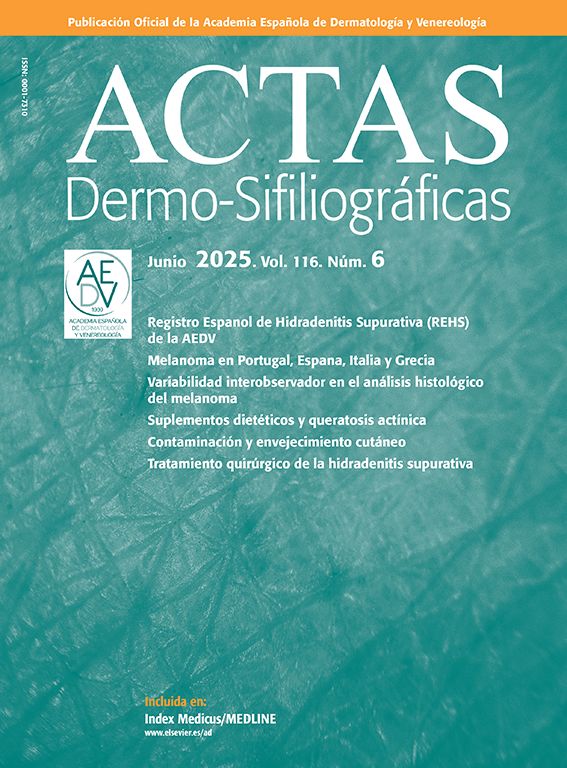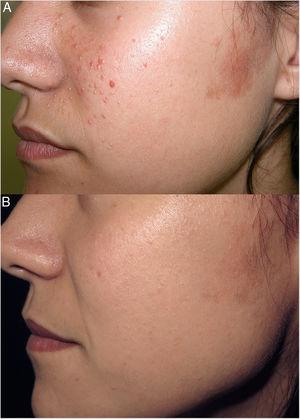A 78-year-old woman presented with a 1-month history of painful digital vesicular lesions on her left hand which had ruptured the week before forming ulcers. Additionally, she reported local itching and paresthesias, but no fever, asthenia, or anorexia. There was no past medical history of infectious processes, drug or contact allergen exposure.
The patient exhibited stage 3 hypertension and type 2 insulin-dependent diabetes mellitus. Additionally, she exhibited peripheral vascular disease and chronic kidney disease for which she underwent hemodialysis through a left brachiocephalic arteriovenous fistula. She remained on insulin on a basal-bolus regimen of carvedilol, furosemide, nifedipine, sevelamer, atorvastatin, darbepoetin, iron oxide, folic acid and calcitriol. No drug allergies were reported.
On physical examination, the patient was afebrile and hemodynamically stable. Heart and lung auscultation were normal. Periungual digital ulcers with friable erythematous bases were identified in the left hand, especially on the 2nd and 4th fingers (Figs. 1 and 2). The brachiocephalic arteriovenous fistula had a palpable thrill and no local inflammatory signs were observed. Radial pulses were rhythmic but diminished bilaterally. Acrocyanosis and decreased pedal pulses were also identified, with no apparent asymmetry between fingers. Aside from acrocyanosis, no other significant skin changes in the right hand, or on the rest of the tegument were reported.
What is your diagnosis?
Diagnosis and commentsThe most suitable diagnosis in this case would be vascular access steal syndrome, an ischemic process that affects 5–10% of patients with brachiocephalic fistulas.1,2 In this clinical entity, collateral circulation fails to provide sufficient distal perfusion and does not compensate for the retrograde flow (or steal) that occurs within the arteriovenous fistula.1,2 Therefore, patients with diabetes or atherosclerosis are at the highest risk for this condition, which is most common in women and patients aged >60 years.1
The diagnosis of vascular access steal syndrome is mainly clinical and 4 stages of severity can be defined. In stage I there are only subtle signs of ischemia, such as cyanosis and decreased temperature, with few symptoms being reported, such as paresthesias. In stage II, there is pain in dialysis or exercise, which can be tolerable (II-A) or intolerable (II-B). Stage III is characterized by pain at rest and stage IV by tissue loss, which can be limited (IV-A) or irreversible (IV-B).1
Aside from steal syndrome, differential diagnosis in this patient, with no past medical history of infectious processes or contact allergen exposure, includes destructive arthropathy and progression of peripheral vascular disease.2,3 However, these two conditions are frequently bilateral, and would not account for the presence of painful vesicular lesions solely on the left hand.2,3
This patient – with painful periungual ulceration on the left hand but still without cutaneous necrosis – had most probably stage IV-A steal syndrome, requiring emergency treatment to prevent progression into irreversible ischemia.1,4
The treatment of steal syndromes involves calculating the flow through the fistula, which was 1847mL/min in this case (measured with Doppler ultrasound). When flow exceeds 1000mL/min, the fistula is classified as high-output, and two surgical treatments are recommended: precision banding or revision using distal inflow (RUDI).4,5 While banding means simply constricting the anastomotic area, RUDI involves closing the flow through the primary anastomosis, thus creating a new fistula with a graft, and then inserting it more distally. While the former technique can lead to fistula thrombosis due to an acute decrease in flow, the latter requires good vascular patency in the terminal circulation, a condition that was not present in this patient who already exhibited advanced peripheral vascular disease.4
Therefore, precision banding was performed. Fifteen days after surgery, the patient remained asymptomatic and the ulcers had disappeared completely (Fig. 3). The arteriovenous fistula remained functional.
In conclusion, painful digital ulcers in patients with peripheral vascular disease should always prompt additional investigation to exclude acute ischemia. In those with arteriovenous fistulas, the timely recognition of vascular access steal syndrome is key to successful treatment.
Conflict of interestThe authors declare that they have no conflict of interest.










